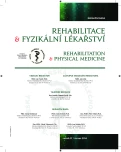Differential Diagnostics of „Scapula Alata”
Authors:
O. Horáček
Authors‘ workplace:
Rehabilitační centrum nemocnice Beroun, Jessenia, a. s.
lékařský ředitel MUDr. J. Calta
Published in:
Rehabil. fyz. Lék., 21, 2014, No. 2, pp. 74-79.
Category:
Original Papers
Overview
Scapula alata is characterized by projection of the lower angle or internal edge of shoulder blade from thorax, which becomes more obvious in a standing patient while stretching forward the arms or leaning against the wall. The insufficiency of m. serratus anterior or the whole complex of the shoulder blade fixator complex, are the main causes of the disorder. Depending on the cause scapula alata can be an insignificant sign or it can result in significant clinical consequences such as shoulder blade instability and disorder on the upper extremity function. There are various disorders which can lead to the development of scapula alata, such as functional falloff of shoulder blade stabilizers, neurological or orthopedic disease etc. The disorder diagnostics in common practice is often based on an imprecise visual evaluation of the examining person. In case of a less conspicuous shoulder blade diversion the sign can easily escape to attention especially if the shoulder blade area is not examined purposely. The disorder can be more easily discovered by purposeful clinical examination using the diagnostic tests. This communication draws attention to diagnostic obstacles and outlines differential diagnostic aspects of the problem.
Keywords:
scapula alata, shoulder blade low fixators, diagnostics, differential diagnostics
Sources
1. AMBLER, Z.: Myopatie a neuropatie. Praha, Triton, 1999, s. 29, ISBN 80-7254-060-2.
2. DUNGL, P.: Ortopedie. Praha, Grada Publishing, 2005, s. 671-672, ISBN 80-247-0550-8.
3. EHLER, E.: Mononeuropatie., Praha, Galén, 2002, s. 37, ISBN 80-7262-125-4.
4. JANDA, V.: Funkční svalový test. Praha, Grada Publishing, 1996, s. 74, s. 86-87, ISBN 80-7169-208-5.
5. JANDA, V.: Základy kliniky funkčních (neparetických) hybných poruch, Brno, Ústav pro další vzdělávání středních zdravotnických pracovníků v Brně, 1984, s. 67, s. 95.
6. JANDA,V., POLÁKOVÁ, Z., VÉLE, F.: Funkce hybného systému. Praha, SZN, 1966, s. 230-231.
7. KOLÁŘ, P.: Rehabilitace v klinické praxi. Praha, Galén, 2009, s. 336, ISBN 978-80-7262-657-1.
8. KOLÁŘ, P.: Gnosticko-percepční funkce a hybnost. Česká a Slovenská Neurologie a Neurochirurgie, 76, 109, 2013, Suppl. 2, s. 258, ISSN 1802 – 4041.
9. LEWIT, K.: Manipulační léčba. Praha, nakladatelství Sdělovací technika, spol. s r.o., 2003, s. 315, ISBN 80-86645-04-5.
10. MARTIN, R. M., FISH, D. E.: Scapular winging: anatomical. Review, diagnosis, and treatments. Curr. Rev. Musculoskelet. Med., 1, 2008, 1, s. 1-11.
11. MUMENTHALER, M., BASSETTI, C., DAETWYLER, C. H.: Neurologická diferenciální diagnostika. Překlad 5. přepracovaného a doplněného vydání. Praha, Grada Publishing, 2008, s. 182-183, ISBN 978-247-2298-6.
12. NEVŠÍMALOVÁ, S., RUŽIČKA, E., TICHÝ, J. et al.: Neurologie. Praha, Galén, 2002, s. 121, ISBN 80-7262-160-2.
13. TUCKER, J.: Posture evaluations. Part 5: A corrective excercise strategy for scapular winging. Dynamic Chiropractic Canada, 4, 2011, 1, s. 1-4.
14. VELE, F.: Kineziologie pro klinickou praxi. Praha, Grada Publishing, 1997, s. 232, ISBN 80-7169-256-5.
15. VELPEAU, A. A. L. M.: Desluxations de l’epaule. Arch. Gen. Med., 1837, 2, s. 269-305.
16. VOJTA,V., PETER. S. A.: Vojtův princip. Grada Publishing, 1995, ISBN 80-7169-004-X.
Labels
Physiotherapist, university degree Rehabilitation Sports medicineArticle was published in
Rehabilitation & Physical Medicine

2014 Issue 2
Most read in this issue
- Differential Diagnostics of „Scapula Alata”
- Evaluation of Postural Stability Using Functional Tests in a Group of Subjects with Transtibial Amputation (A Pilot Study)
- Electroencephalographic Correlates of Performance Motivation and Fatigue
- Rehabilitation Method KLIM-THERAPY – Reflections on the Mechanisms of Clinical Effect
